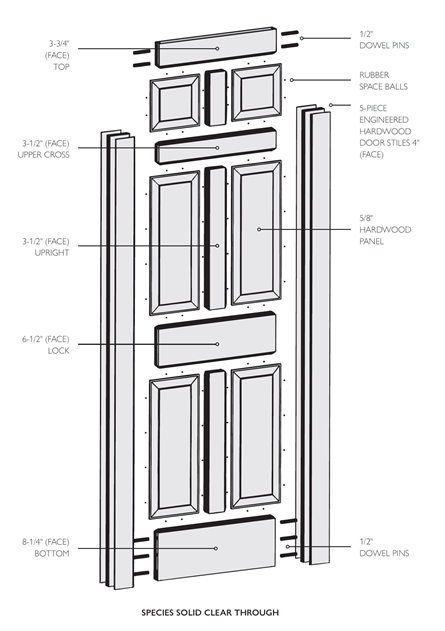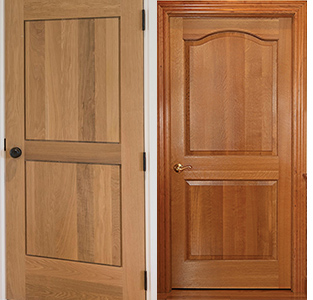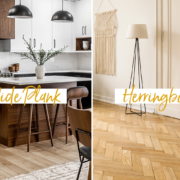Buying Guide: Ordering Custom Interior Doors for Your Home
What’s the one item found in every single home and used by every person who steps foot inside? Doors!
Interestingly, many homeowners tend to think that options are limited when it comes to interior doors. But, interior door designs are virtually limitless and can be a great way to reflect your personality and style! Of course you want your doors to provide privacy and security, but they can also be great accent pieces, too.
Whether building a new house or renovating a space, a new interior door can make all the difference. Design a custom door that creates a comfortable, inviting space while being an investment that can last a lifetime!
Are Solid Wood Doors REALLY that Different from the Big Box Options?
It’s simple. Solid wood doors are more durable than other materials and last for decades, if not longer. Interior wood doors have a standard height of 80 inches and widths in 2-inch increments (much like exterior doors), but they certainly aren’t one-size-fits-all! In fact, doors can be made completely custom for a space, accounting for different measurements in different areas of the home.
Essentially, when it comes to interior doors, you have three choices: solid wood, solid core and hollow core. If you’re looking for craftsmanship, customization and sound blocking, nothing really compares to solid wood. Plus, they help to boost the value of your home! In the end, solid wood door options cost more than hollow core designs, but they will stand the test of time.

Parts of Interior Doors
With custom hardwood interior doors, the panel makes up the largest part of the door. This area can have its own detail, including flat, raised and applied moulding designs.
Rails are the horizontal sections of a door at the top and bottom of a door, while stiles are vertical pieces on the outer part of a door. The sticking profile of the stiles and rails can be fully customized with straight, beveled or detailed edges, as well.
Why Choose a Custom Wood Door
When you’re deciding on your next interior door, why should you choose a custom wood door?
The benefit of designing your own custom wood doors is that they can be designed to best represent the room or space. For example, you might want a more elegant design on your wine cellar door than the one leading to the kid’s bathroom (so you choose primed poplar for the bedrooms and custom solid cherry for the wine cellar!).
Wooden doors come with a lot of options, from choosing between species to adding accents. You can even add glass options! The best part about custom doors is that each one can be unique or exactly the same — whatever you choose!

How To Design Your Custom Interior Door
Now that you’ve decided to design your own wooden door, it’s time to look at your options.
Naturally, you’ll start by determining the type of door you need. Once that’s decided, you’ll choose the species and design elements. With Baird Brothers, the process to pick out a high-quality door is easy.
1. Pick a Door Style
Start by choosing from one of ten groups of Baird Brothers Fine Hardwoods interior door designs. If you can dream it, we can do it: from a louver closet door to a completely custom two-panel pocket door.
Barn doors are another popular choice because of their sliding feature, which adds a distinct charm and often helps to save space. Baird Brothers also offers French doors designs, a double door option that adds sophistication. (Wooden french doors also look great with a glass feature.)
Some door styles are available as pre-hung options, too. Pre-hung doors come ready to install with attached hinges to ease the process between purchase and installation.
2. Choose a Wood Species
The next step in purchasing any hardwood product is to select the species of wood. With Baird Brothers, there are plenty of wood species to choose from that are sure to fit any homeowner’s needs or preferences. Some of the most common and popular woods include the following:
-
-
- Alder: a member of the hardwood family but on the softer side.
- Walnut: sturdy and stable wood, oftentimes used for carving detail.
- Oak: strong, heavy and versatile wood.
- Mahogany: another strong wood used for intricate carving.
- Hickory: one of the strongest domestic woods.
- Maple: Strong, reliable and commonly used for furniture or cabinets.
- Medium Density Fiberboard (MDF): dehydrated hard or softwood fibers processed into panels.
- Poplar: a softer hardwood often utilized for painted applications
-
Just like a fingerprint, each hardwood has its own unique characteristics. Texture, grain pattern and color should be considered when choosing an interior door. Keep in mind that some species are better suited for certain applications (ie – softer woods should not be used for flooring).

3. Add Finishing Touches
As with anything else, accessories add character — and doors are no exception! Custom glass panels, prefinished colors and hardware add layers of depth to solid wood interior doors.
When designing your custom wood door, there are seven considerations you have to make before purchase:
-
-
- Hinge Color
- Jamb Color
- Door Stop
- Magnets/Ball Catch/T-Astragal
- Hardware (Handles & Locks)
- Glass Option
- Slab (Door Style & Measurements)
-
Hinge color and jamb color will likely depend on the style of the home. If you want to add glass to your interior door but don’t want to lose privacy, consider a patterned glass option. When ordering custom doors from Baird Brothers Fine Hardwoods, all of this information needs to be specified upon order.
Get Started By Ordering Custom Interior Doors
That’s it! Now you have an outline for custom solid wood interior doors – simply choose a door style, pick out a wood species and then design!
Start the process by looking at our hardwood products online and then reach out to our sales team to see what our craftsmen can make for you. We’ll help you collect all of your door requirements and specifications to ensure you get exactly what you’re looking for!














